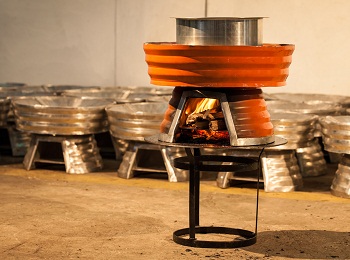Clean Data for Cleaner Cookstoves: Smartphone app helps improve a life-saving product
Globally, slightly fewer than 3 billion people cook their daily meals on inefficient devices fueled by charcoal or firewood. The United Nations Framework Convention on Climate Change estimates that only 10 percent of the energy in the fuel is utilized to cook, so much more fuel is consumed than is needed. In addition, the low combustion temperature in the inefficient technologies results in only partial combustion of the fuel, releasing particulate and carbon monoxide emissions, among other pollutants.
The widespread use of this cooking method has both global and local repercussions. Emission of global warming gases, rapid deforestation and loss of animal habitat are among the problems caused, but the immediate tragedy is that 4 million people die every year from indoor air pollution associated with these basic cooking technologies. People who cook this way, mostly women and girls, are exposed to pollutants equivalent to smoking two packs of cigarettes per day.
Replacing the inefficient technology with clean cookstoves has been hailed as the solution to these environmental and health problems. There are many types of clean cookstoves being developed, distributed or sold, and they range from simple devices that cost less than $5 to complex products costing more than $40, which are hyper-efficient or boast nifty services such as mobile phone charging.

The $5 clean cookstoves can often be made from local materials, cut fuel use by half and drastically reduce exposure to indoor air pollutants. The more expensive technologies use even less fuel and sometimes eliminate emissions completely through solar energy or renewable biomass.
(Left: A clean cookstove by Top Third Ventures.)
Most clean cookstoves rely upon the Rocket Stove design, which was developed by Dr. Larry Winiarski in 1982. More than 30 years later, clean cookstoves are still not in widespread use and premature deaths from air pollution exceed deaths from malaria and AIDS combined. Why? My belief is that the social impact associated with clean cookstoves has overshadowed a factor critical to the success of any product or technology: a deep understanding of your customers and what they want.
Examples of this are the unveiling of new clean cookstove technologies at United Nations conferences, and top-down imposition on BoP consumers of camping stoves developed for outdoor enthusiasts in the developed world.
Developing clean cookstove technologies and getting these into the hands of customers will help prevent premature deaths from indoor air pollution, reduce deforestation and solve other problems associated with inefficient cooking – but only if these new technologies are adopted. To achieve widespread, continued use and realize the benefits of clean cookstoves, the industry needs to bring the focus back to the customer.
BoP consumers have a lower budget than consumers in developed countries, but I think their behavior is surprisingly similar. Both want products or services that improve their lives and make them feel better about themselves. To achieve widespread adoption, clean cookstoves need to be designed with a bottom-up approach with the focus on the culture, habits and aspirations of the target customer.
As important as keeping the customer in mind from the beginning is constantly communicating with them to improve or modify the product. With this initial goal in mind, Top Third Ventures developed a smartphone application to collect customers’ contact information for after-sales analysis. We then realized that if socioeconomic data is added to our customer profiles, valuable insights are gained into the behavior of a consumer group about which very little is known, as most do not have Facebook profiles or use Google on a daily basis.
Even a small data set can illustrate the percent of early adopters in a consumer group, and their typical profession and monthly income. Over time, the data will illustrate the lag between early adopters and more typical consumers. If existing customers are incentivized to update their information – for instance, by maintaining eligibility for a warranty – then you can track changes in their income and health.
By tracking the children under age five of existing customers, over the three-year life of a Top Third Ventures clean cookstove – and having the customers update their information regularly – we can deduce an infant mortality rate. This way, Top Third Ventures can show that the infant mortality rate among its customers is below the national average and will be confident it is realizing the elusive social and environmental benefits from clean cookstoves.
Lucas Belenky is the CEO of Top Third Ventures.
- Categories
- Health Care, Technology
